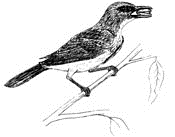Vertebrate Pest Conference: Proceedings

Vertebrate Pest Conference Proceedings: 17th (1996)
Date of this Version
1996
Document Type
Article
Citation
Published in Proceedings: Seventeenth Vertebrate Pest Conference … 1996, ed. Robert M. Timm & A. Charles Crabb (University of California, Davis, 1996).
Abstract
Twenty-five Conservation Reserve Program (CRP) contract holders in Riley County, Kansas were surveyed by telephone to assess their perceptions of wildlife damage relative to CRP plantings. Sixty-four percent experienced wildlife damage on their farm or ranch. Respondents felt that five species causing damage on their farm or ranch had become more common due to enrollment of lands in the CRP. White-tailed deer (Odocoileus virginianus) accounted for 64.3% of these observations, followed by wild turkey (Meleagris gallopavo), eastern cottontail (Sylvilagus floridanus), striped skunk (Mephitis mephitis), and Virginia opossum (Didelphis virginiana), which accounted for 14.3 %, 7.1%, 7.1%, and 7.1% of the damage observations, respectively. Only 12.5% of respondents attempted to control wildlife damage, and none felt that wildlife damage was severe enough to preclude future enrollment in programs such as the CRP. Most respondents allowed hunting or trapping by non-family members on their CRP lands (68.8%), but none felt that increased hunting or trapping would reduce the amount of wildlife damage they experienced. All respondents felt that the benefits of the CRP exceeded costs associated with wildlife damage and that the program was highly beneficial overall.
Included in
Animal Sciences Commons, Bioresource and Agricultural Engineering Commons, Environmental Engineering Commons


Comments
Copyright © 1996 (where applicable) by the Vertebrate Pest Council of the Vertebrate Pest Conference. Used by permission.